RVs are like homes – they have a multitude of systems to tend to, such as plumbing and electrical systems. When something isn’t working properly, for example when there’s no hot water in your RV, the troubleshooting process begins. Sometimes we find that some part of the system has failed, but other times we find that we’ve simply made a mistake.
Particularly when you’re new to RVing (as we were nearly two decades ago), you can accidentally do something that you don’t realize can cause what appears to be a system failure, when really you’ve just made a newbie mistake that caused the issue you’re now troubleshooting.
That happened to us when we were newbies (and occasionally still does!), and we like to share those experiences for the benefit of newcomers to the RV world who might encounter similar situations.
So, today we’re looking at how you get hot water in your RV, what might be happening if the water stops running hot, and (hopefully) how to fix it.
How Do You Get Hot Water in Your RV?
Like a house, an RV has a water heater. The heater could run on propane or a combination of propane and electricity like ours, it can be a tankless hot water heater, or you could have a hydronic system that is diesel or propane-fueled and provides both heat and hot water.
When your RV’s hot water system is working properly, you have all the hot water you desire, within the limits of the water heater tank size.
There are a number of informative RV water heater tips that are important to know about, and that will almost certainly be helpful to you in some way. But let’s take a look at what happened to us back when we were newbies, in hopes of sparing you a similar fate!
Why Was There No Hot Water in Our RV?
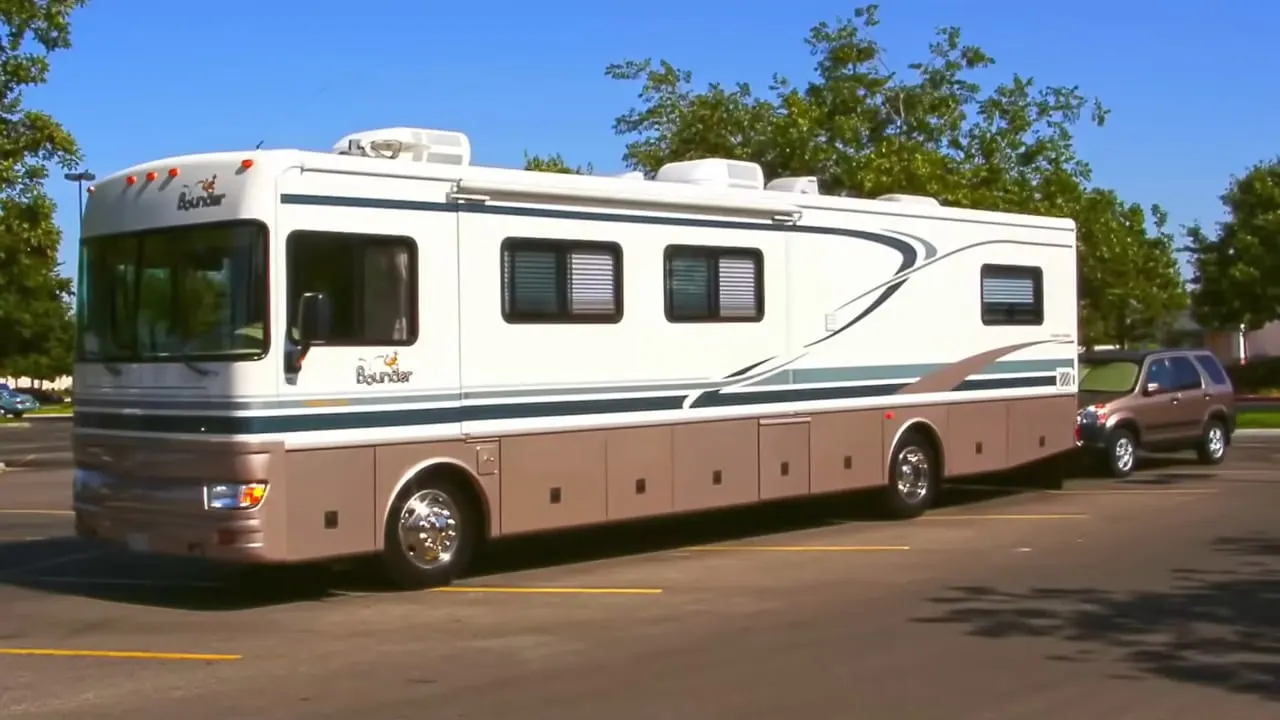
Very early on in our tenure as RVers, we experienced the problem of no hot water in our RV. We had inadvertently caused the problem ourselves, and it was a very simple fix.
One day when we were new RVers traveling and living in our 2002 Fleetwood Bounder Diesel, we found that the water running in our kitchen sink wasn’t getting hot. It was just lukewarm, which was very unusual.
So, we set about troubleshooting the issue of no hot water in our RV by checking all of the obvious possible issues. First, we checked the main power switch on the water heater – and it was on.
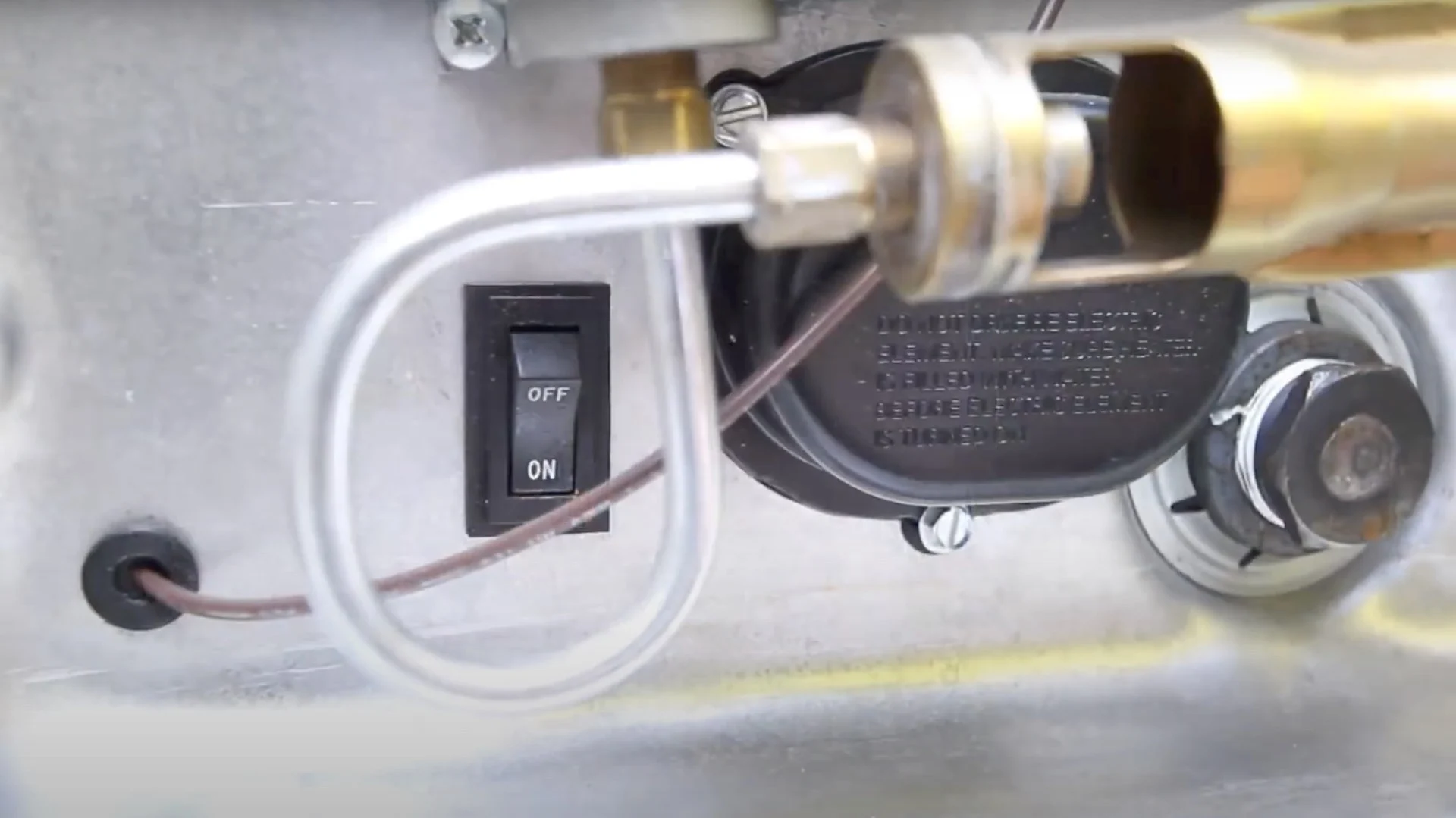
First, check the main power switch on the water heater to make sure it’s on! On our Suburban, it’s under the outside cover in the very lower left corner, as shown here.
Next, we checked to see if the water heater circuit breaker was tripped. Nope – not the issue.
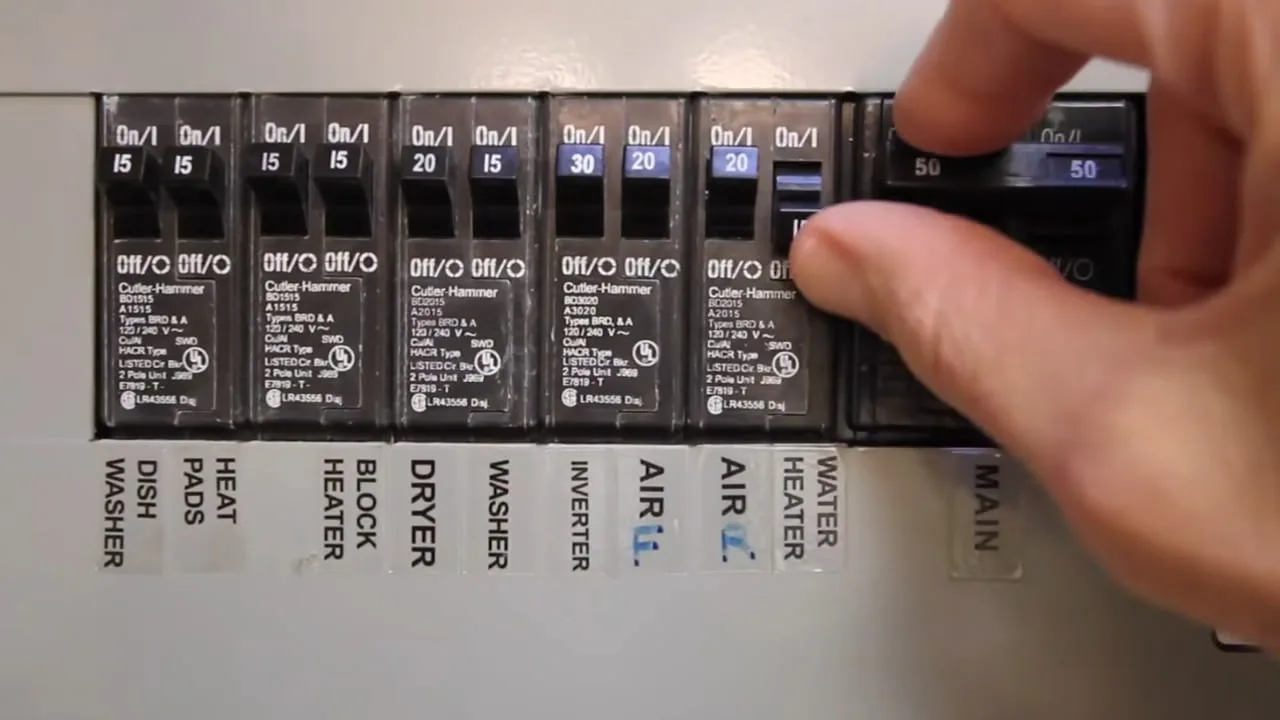
Check the circuit breaker for the water heater.
We noticed that when the propane heating was turned on the ignition light didn’t illuminate. Hmmm…
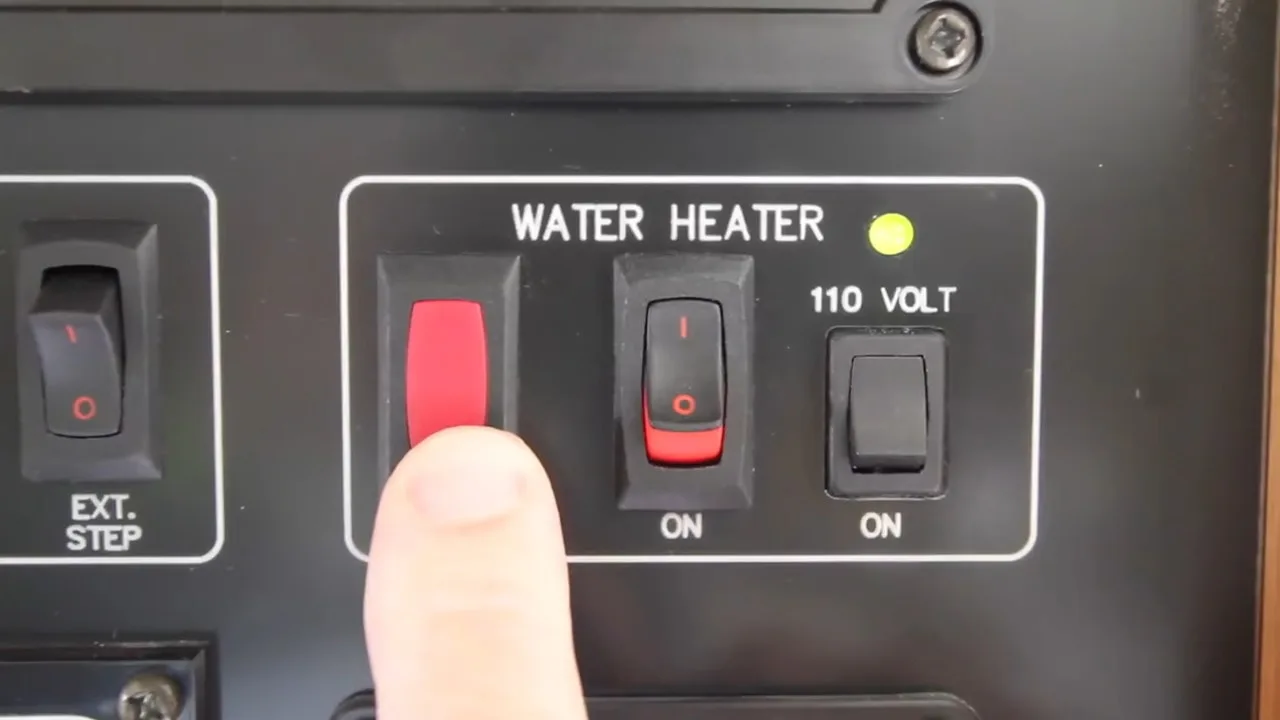
In our scenario, we found that the propane ignition light didn’t illuminate when we turned on the propane heat.
We checked to make sure the propane was turned all the way on at the tank. Perfect. We checked the propane level as well. Plenty of propane.
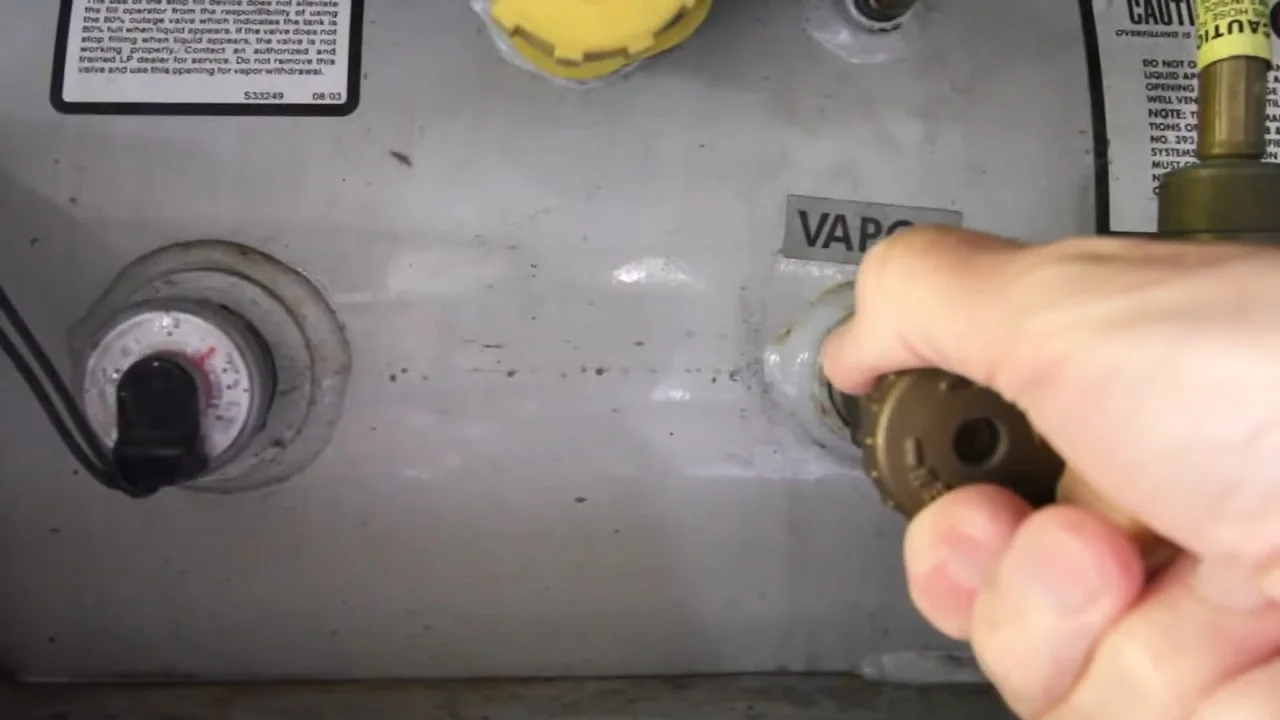
We checked to make sure the propane was turned on and there was plenty of propane in the tank.
Being new to the business of RVing, we had investigated the issue of no hot water in our RV as thoroughly as we could, so we drove our rig to an RV repair person who quickly diagnosed our issue – and the mistake we’d made that caused that issue!
It turns out, it was entirely our own fault! ???? We had run the outside shower using both the hot and cold water, and while using it, we had turned the water off using the control on the showerhead, but we’d left the hot and cold faucets turned on.
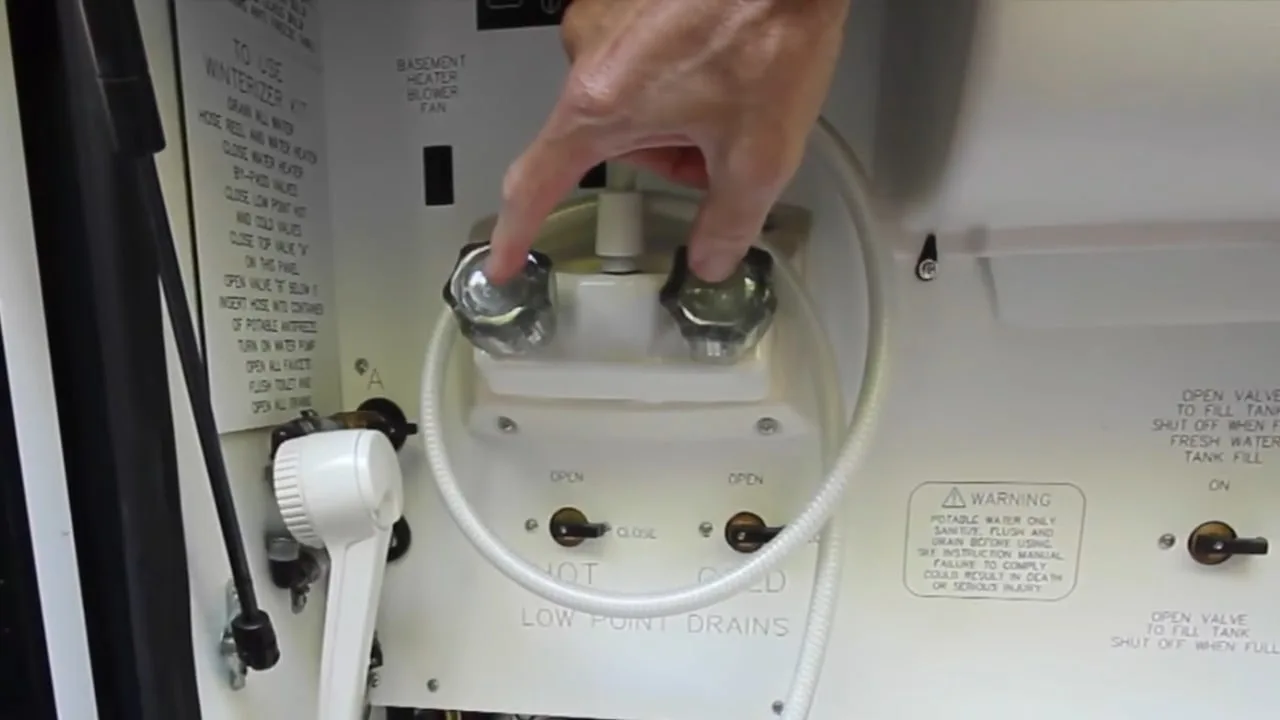
We had used our outside shower, and we’d turned the water off on the showerhead itself, rather than closing the faucets. (Hey – we were newbies once, too!)
In our particular system (and from what we’ve heard from MANY others), leaving both the hot and cold faucets on opens a connection between the hot and cold sides of the water system, allowing the cold and hot water to mix.
The reason the water heater wouldn’t fire up using propane was simple – the water in the water heater was already hot!
With the outside shower’s hot and cold faucets properly shut off, the temperature of our water was about 124 degrees. But with both faucets open, the temperature of the water was lukewarm, at around 102 degrees. And THAT’S what had made us think the water heater wasn’t working properly.
No Hot Water In Your RV? Watch This Video First!
If you find that your water is running lukewarm, check to make sure you haven’t made our newbie mistake. If you’ve ruled that out, then we have some additional suggestions for your troubleshooting list.
What Else Could Be Wrong With Your RV’s Water Heater?
Depending on the make, model, and type of water heater you have in your RV, all the following suggestions may or may not apply. But the following RV water heater troubleshooting tips offer some great steps to follow when you’re investigating the issue of no hot water in an RV.
Refer to Your Water Heater Manual
Yeah, we know – this one should be obvious, but we had to include it because it’s always the first step when troubleshooting any issue. Often your owner’s manual will have a list of troubleshooting steps that are particular to your brand and model, so this is always a great place to start.
If you don’t have the manual for your water heater, it should be available online. Just Google the make & model like this: “Suburban SW12DE owner’s manual”
In that vein, we always suggest printing/downloading a copy of owner’s manuals that you don’t have for any appliances or equipment in your RV so that if you’re in a remote location and can’t access the internet, you’ll have what you need on hand (and, of course, you’ll have trouble and need the manual when you’re in a remote location without access to the internet… late on a Friday… of a holiday weekend ????♂️).
Check to see if your hi-limit/emergency cut-off switch (which is the fail-safe to shut the water heater off if the thermostat fails to keep the temperature below a set high limit point) needs to be reset. The switch can trip, and simply pushing the button back in can reset it and have you on your way to a nice hot shower.
However, if the switch trips repeatedly, then your thermostat needs to be replaced. (We’ll touch on this one later.)
Propane/electric RV water heaters will have two hi-limit/E.C.O. switches – one for the electric heater and one for the propane heater.
The thermostat(s) and their hi-limit/emergency cut-off switches sit under a cover that looks like this one, located behind the outside cover to the water heater itself.
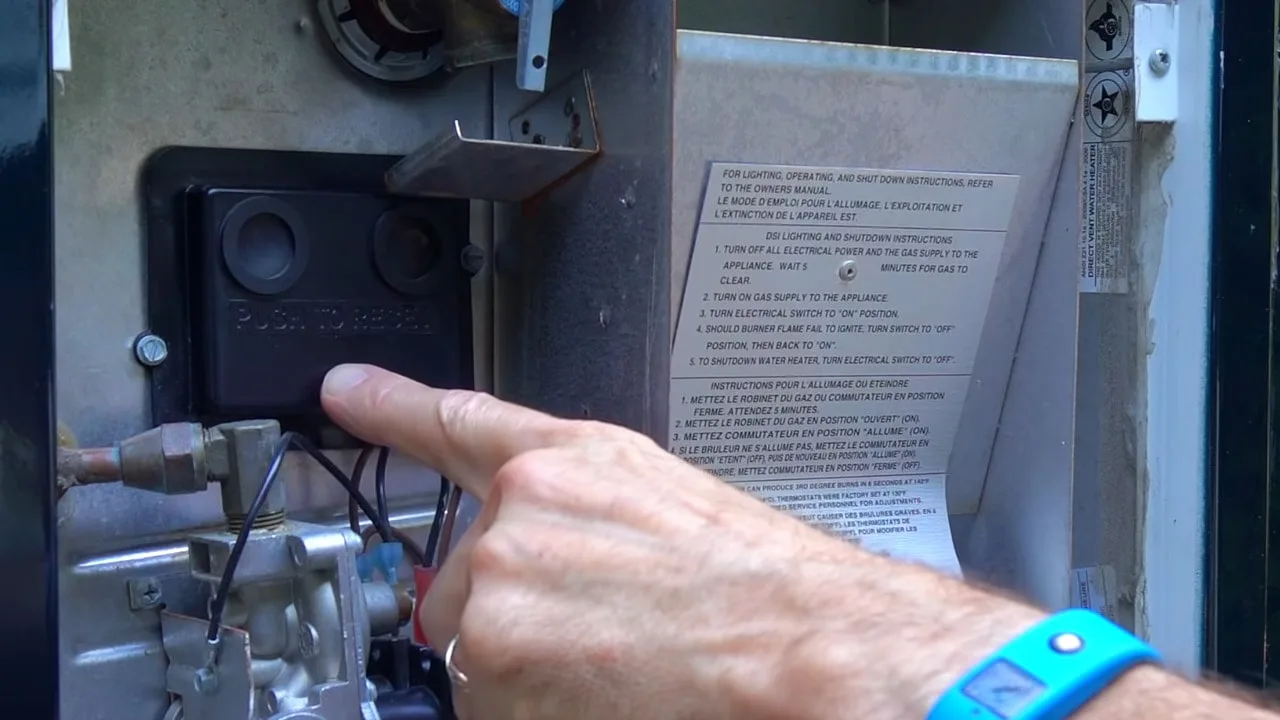
Press the rubber, circular button to reset your thermostat’s hi-limit/emergency cut-off switch. (You may have two – one for propane and one for electrical – as we do.)
All you need to do is press the circular, rubber button(s) on the cover to reset each of your hi-limit/E.C.O. switch(es), just like that. If you feel the reset button click back into place, that was your trouble. If, however, you push on each reset button you have and they don’t move/click… they hadn’t tripped… and that WASN’T your problem.
FYI, the thermostats themselves look like this, and that little gray cylindrical piece you see at the top of this thermostat is the actuator for resetting the hi-limit/E.C.O. switch. That’s what you’re pressing on when you push on the circular rubber button.
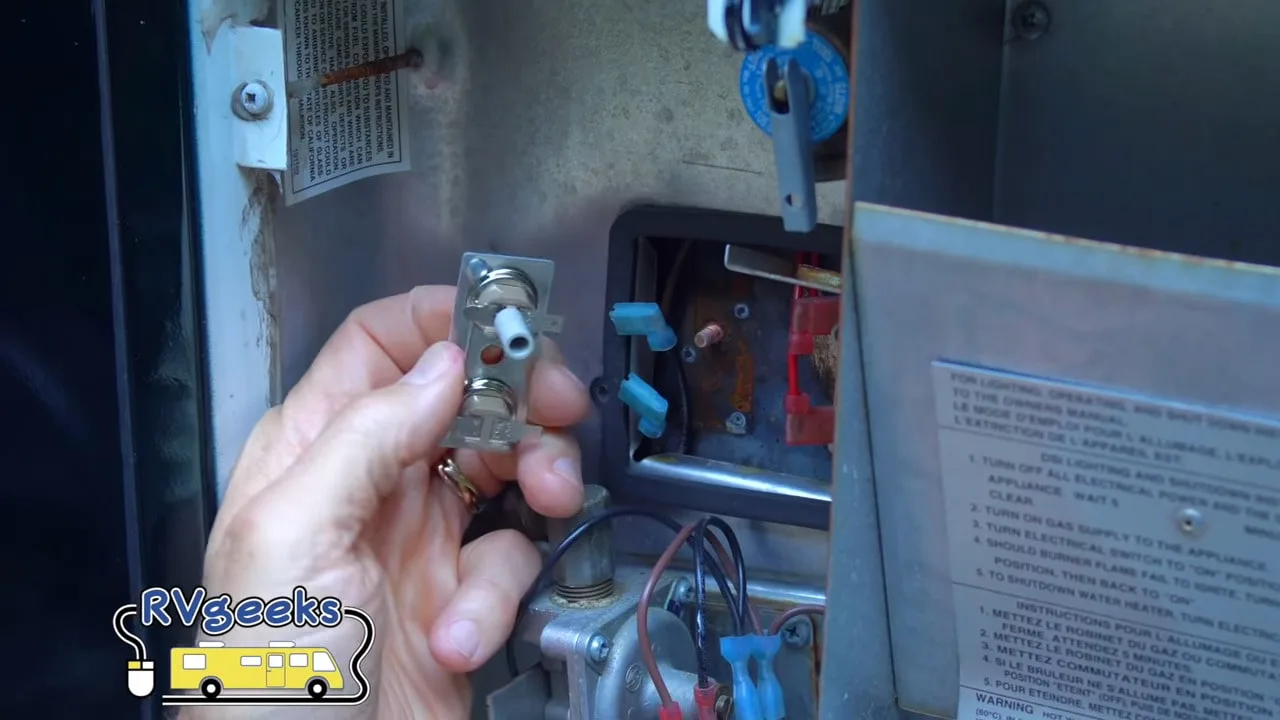
This is what the hi-limit/E.C.O. switch looks like under the cover.
Check Bypass Valves
If you’ve sanitized your water system, or if you’ve winterized your RV for the season, you’ve likely closed the water heater bypass valves to allow the water heater to be bypassed during the process.
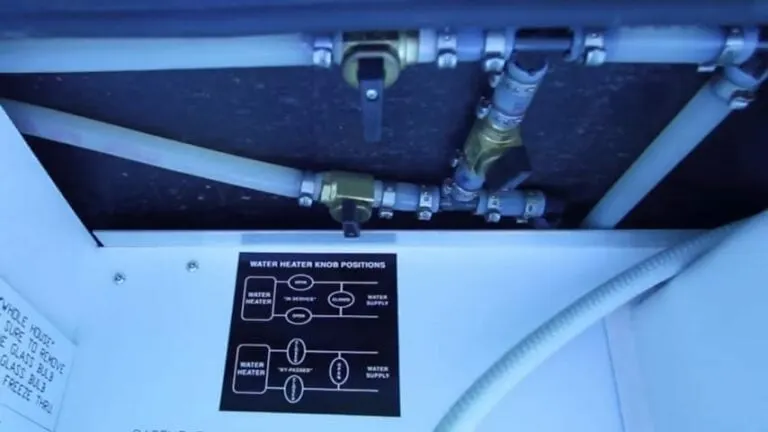
You may have closed your bypass valves when you winterized your RV or sanitized your water system. You may also have forgotten to re-open them!
Be sure to check these valves to make sure they’re in the correct position(s) to give you hot water! It’s very easy to forget the bypass valves, so when troubleshooting an issue of no hot water in your RV, this is one of the first things we recommend checking.
Check Your Propane Levels
Another easy troubleshooting step if there’s no hot water in your RV is to check your propane levels. If your propane tank is empty, or even if it’s very low, and you’re trying to heat your water using propane, you won’t get hot water. Fortunately, there are easy ways to check your propane level.
The first, of course, is to simply read your tank’s gauge. But even if you don’t have a gauge, checking the level of propane in your tank is easy. There are a couple of different ways you can do this.
If you have a propane stove, you can simply light one of the burners to check for a constant, full flame. If the stove lights and stays lit with a normal flame, you’ve got propane in your tank. If you use this method, however, be sure not to leave your stove running for too long – just long enough to perform this check. And as always, never walk away from a stove that’s lit!
If you’d prefer to use another method to check on the propane level in your tank without a gauge, check out this post where we lead you step-by-step through this very simple method using nothing but some hot tap water. Of course, since you’re not getting hot water in your RV, you may need to obtain it from some other source, like the bathroom at the campground!
Check the Electric Heating Element
If you have an electric water heater, check the electric heating element. These can corrode over time and can even melt if the water heater is left on with no water in it.
Replacing your electric heating element is not a difficult process. You’ll likely access the heating element from the outside of your RV, and you’ll need a simple heating element wrench like this one:
- ✅The overall length is 6" (150mm) with 8mm cross holes for turning, providing the clearance needed for a correct connection and easy loosening -...
- ✅This Heavy-Duty hot water heater element wrench combine with anode rod removal tool easy to use features A3 Carbon Steel Galvanized Construction...
And you can pick up replacement heating elements for your water heater at any local RV parts supply… or online:
- mounting type: screw-in
- package dimensions: 3.7 l x 27.7 h x 6.1 w (centimeters)
- Pilot Water Heater Replacement Part
- 110 VAC Element/Gasket Kit
Faulty Thermostat
If you’ve got no hot water in your RV, another possible culprit is a faulty thermostat. If your thermostat needs to be replaced, this is generally something you can do yourself, should you feel so inclined.
You can see how to check for a faulty thermostat using a multimeter in this video, and if you find you need to replace your thermostat, it’s one of the easiest DIY projects you can do, especially if you watch our step-by-step tutorial video, below.
Again, you can likely pick up a replacement thermostat for your RV’s water heater at a local RV parts supply shop… or you can get them online:
Suburban 120V Thermostat (#232306):
Suburban 12V/Propane Thermostat (#232282):
No products found.
Atwood ECO Thermostat Assembly (#91447 – for gas/electric water heaters):
- 1.Water heater repair parts for RV, Motor, Home,etc.
- 2.Fits Models:GCH6-4E, GCH6-6E, GCH6-7E, GC6A-7E, GH6-6E, GH6-7E, GH6-8E, G6A-6E, G6A-7E, G6A-8E, GCH6A-7E, GCH6A-8E, GCG6A-9E, GC6AA-7E, GC6AA-8E,...
RV Water Heater Check Valve Malfunction
If you’ve got low pressure at your hot water sources – if your water is flowing at a trickle, for example – you may have a water heater check valve malfunction.
The check valve exists to ensure that hot water only flows in one direction (out of the water heater) and prevents the backflow of cold water. If you have low pressure – or no pressure – flowing from your hot water faucets, that’s a fair indication that you may have a problem with the check valve.
To replace the check valve, you’ll need to drain your hot water tank, unscrew and pull off the old check valve (which you’ll do from behind the water heater where all the water connections are located… depending on your RV’s construction, you may have access to this from inside your RV), and replace it with a new one.
Conclusion
Hopefully, after following these troubleshooting tips, you discovered that the issue causing you to have no hot water in your RV was solved as simply as ours was, and you’ve been able to enjoy a nice hot shower.
If not, be sure to check out the links and videos posted above in this article for more detailed information that will (hopefully) lead to an easy resolution, bringing the luxury of hot water back into your RV.
Geek Out with Us Every Week
Join our newsletter to learn about all things RV-related. Every week we offer free tips, tricks, product reviews, and more to our online community of RVers. So, whether this is your first time on the road or you’re a seasoned expert, we’d love for you to geek out with us!

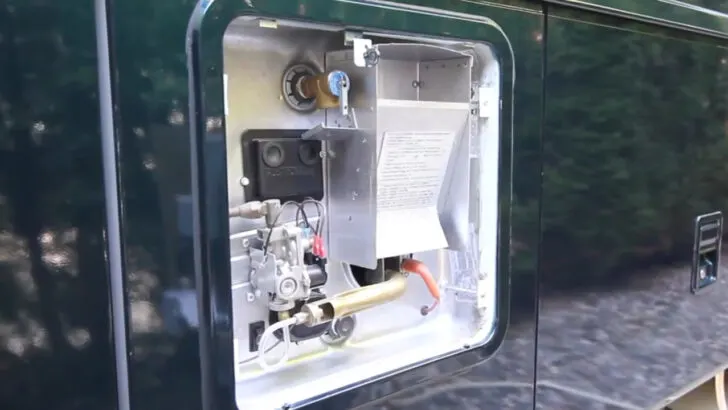





Jeff
Monday 12th of February 2024
We recently had some cold weather come through and I thought I had done good enough job of winterizing the water lines. Well come to find out, I didn't. So the lines froze up and now my water heater will not work. I replace the heating element in my Sw6de a few months prior. I don't run propane due the fact goes way to fast so it's just running on electric. Would the heating element burn up if the lines froze up? If not then any suggestions?
Suburban SW6DE
TheRVgeeks
Monday 12th of February 2024
Hey @Jeff. Sorry to hear about your winterizing issue. We can't see any specific connection between some plumbing lines freezing and your water heater not working now. But saying that your "water heater will not work" is a little vague, too. Is it that it isn't heating water? Have you tested it on propane (we understand you don't want to run that way for good, but it's helpful to troubleshoot what does and doesn't work)? Do you get any water flow at the sink when you turn on just hot? Or is it just running ice cold? The answers to these questions can really help pinpoint the problem more specifically.
Our bet is that the water heater is still working just fine (if you have a way to confirm that the water heater is pulling its usual amount of 120V AC power when you turn it on with cold water in the water heater tank and plugged into shore power/gennie... or, if after heating up for long enough, you can CAREFULLY let some water out of the water heater's overtemp/overpressure valve to see if it's hot). It's most likely that when you de-winterized the RV, some valve(s) somewhere is(are) still in the wrong position, so the water heater is still isolated and no hot water can come out. If your issue is that you turn the water heater on and wait to let it heat (and confirm the water in the tank is now hot), but then when you run water at the faucet all you get is cold, we'd start tracing the water lines and look for any/all valves that you may have turned for winterizing (some may be on the back of the water heater itself) and didn't get put back.
Brian
Thursday 19th of October 2023
My propane water heater will ignite run for 8 seconds and then shut off then repeat run 8 seconds then shut off.
TheRVgeeks
Tuesday 24th of October 2023
Oh no, Brian. Sorry to hear about the trouble. Could be any of the following:
Bad flame/ignition sensor Bad/failing circuit board Propane problem... low tank or clogged regulatorIf the flame burns steadily for the short period that it's staying lit... and if all the other propane appliances (stove, fridge, and furnace) are all working OK, we'd rule out propane problems. Since the circuit board is the most expensive, we'd save that for last. So we'd look for the circuit diagram for your make & model of water heater and see if you can identify if it has a thermocouple/thermistor that's used to confirm that the propane is burning properly and staying lit. It may be a combination part with the burner orifice or ignitor.
Hope this helps.
Keven Clark
Saturday 20th of May 2023
Keven and Val. First trip out after a winter in Arizona and no hot water and had no issues before. After going through what I thought was everything, I found your video on YouTube. Lo and behold I hadn’t flipped the bypass valve! Hot water abounds!!! Thanks guys.
TheRVgeeks
Monday 22nd of May 2023
Glad to hear you found the culprit, Keven!
Ray clor
Saturday 29th of April 2023
We had problem with warm water in kitchen and no hot water by watching videos rvgeeks save me outside shower both values open causing mix cold and hot together then shut both values we got water thanks to rvgeeks
TheRVgeeks
Saturday 29th of April 2023
Glad to hear we could help you troubleshoot, Ray! Enjoy the hot water! ????
Michael Haynes
Friday 3rd of March 2023
In my Crossfire Bullet hot water flowed about 1/3 of cold water at every faucet. Had a Factory Installed KINK in the cold water line feeding the shower and water heater. Took an endoscope to find it!